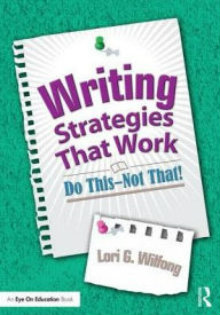Practical Research Based Writing Strategies
Writing Strategies That Work: Do This–Not That!
By Lori G. Wilfong
(Routledge, 2015 – Learn more)

Lori G. Wilfong knows how to write for teachers: concise, conversational-style, practical ideas! In Writing Strategies That Work: Do This–Not That!, she presents current best practices in writing. This is an excellent resource for teachers of all grades and all content areas. The book provides teachers with multiple ideas and strategies to use in the coming school year.
According to the author, these are the 10 Do This! strategies:
Let writing come from a place of writing, taking students through three types of writing necessary for building a Common Core Writer’s Workshop.
- Develop thoughtful, short writing prompts that are “infinite” not finite.
- Have students read, critique and learn from master authors in the genre they are writing.
- Create a writing community in your classroom.
- Use anchor charts and mini-lessons to explicitly teach writing.
- Emphasize content and revision when helping students develop as writers, teaching editing in context of the student writing.
- Use conferencing to grow students as thoughtful, reflective writers.
- Let narratives be personal and creative, focusing on details and imagery to make a story come to life.
- Let informational writing explore a topic creatively.
- Let argument writing be situated in real-world application.
Dr. Wilfong opens each chapter with a classroom anecdote, followed by a section titled “Why Is This Item On The List So Important?” While answering that question, she includes relevant research along with connections to the Common Core State Standards.
After this quick overview, she moves readers to the most pressing topic, “Instructional Practices to Update.” Readers will find the author’s strategies and activities very easy to implement. Action steps and reflection items at the conclusion of each chapter help move a teacher toward improved writing instruction.
A peek into a favorite chapter
Chapter 3: Do This – Have students read, critique and learn from master authors in the genre they are writing.
I found this chapter to be loaded with ideas and suggestions for leading students to pay attention to the author’s craft. She addresses three instructional practices to update:
Updated Strategy #1: Consider Texts for Both Comprehension Instruction and Author’s Craft That Meet the Genre You Are Emphasizing in Each Unit
Wilfong discusses using mentor texts to teach the craft of writing and reminds us that the key to success “is to narrow down the focus to the one or two elements in which a particular text excels.” (page 45) After deciding what reading strategies to address with a particular text, Wilfong suggests reading the text a second time to determine what writing techniques are used.
She archives excerpts, passages, and examples in a running document on her computer. (I need to update my practice of saving to index cards!) Wilfong encourages content teachers to use mentor texts to help students learn “to write from a particular point of view and for a particular audience, adding depth to a piece.” (page 47)
Updated Strategy #2: Encouraging Students to Read for Author’s Craft
While teachers may initially select the mentor texts, the goal is for students to identify and analyze the author’s craft in their self-selected texts. To help students internalize this strategy, she suggests a five-step lesson that is easy to implement.
Updated Strategy #3: Using an Author Study to Delve Deeply Into an Admired Author’s Craft
Wilfong encourages author studies beyond elementary school. Figure 3.1 (page 50) shows the steps in an author study cycle for middle and high school students.
Concise, conversational and ready to use
In Writing Strategies That Work: Do This–Not That! readers will find a mix of old and new strategies. For example, using the idea behind Think-Pair-Share, Wilfong created a Think-Pair-WRITE! template to help struggling students develop a plan for writing. An assistive technology strategy new to me was the Dragon Dictation app. (FYI: my 8th grade grandson and I tried it out and found it easy to use! Just be sure students speak the punctuation marks!) Teachers will find evidence-based support for these and other practical teaching ideas in this excellent book.
Anne Anderson finally got out of the 8th grade after 24 years and 9 weeks. She spent the next 9 years sharing her expertise in literacy and writing with K-12 teachers and administrators throughout the district. She credits National Writing Project and Poetry Alive! as turning points in her growth as a teacher. She now shares her expertise nationwide as an educational consultant and through her website and her bi-monthly newsletter, Spotlight on Success.





































